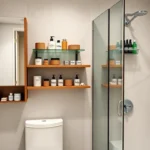We’ve all dreamed of that perfect open-concept space where cooking becomes part of the entertainment. Open kitchen living room designs have revolutionized modern homes by creating seamless flow between two of our most-used spaces. This layout isn’t just about knocking down walls – it’s about crafting a cohesive environment where family gatherings and daily routines blend effortlessly.
The beauty of open kitchen living room concepts lies in their versatility. Whether you’re working with a compact apartment or a sprawling family home we’ll show you how to maximize both functionality and style. From strategic furniture placement to clever design tricks these spaces can feel larger while maintaining distinct zones for cooking and relaxing.
Ready to transform your home into an entertainer’s paradise? We’re diving into the most stunning open kitchen living room ideas that’ll inspire your next renovation project and help you create the perfect backdrop for life’s everyday moments.
Define Your Zones With Strategic Furniture Placement
Strategic furniture placement transforms your open kitchen living room into distinct functional areas while maintaining visual flow. We’ll show you how to create defined zones without building walls or compromising the open concept design.
Create Visual Boundaries Using Area Rugs
Area rugs serve as the foundation for defining separate spaces in your open floor plan. We recommend placing a large rug under your seating area to anchor the living room zone and create clear visual separation from the kitchen. Choose rugs that complement your overall color scheme while providing enough contrast to establish boundaries.
Size matters when selecting rugs for zone definition. Your living room rug should extend at least 6 inches beyond your sofa on all sides, with front furniture legs resting on the rug surface. Consider adding a smaller rug in your kitchen dining area to further distinguish the cooking space from the relaxation zone.
Texture and pattern choices help reinforce the separation between zones. We suggest using different rug textures to create subtle transitions, such as a plush area rug for the living space and a flat weave option for the kitchen area. This approach maintains cohesion while clearly defining each functional area.
Position Sofas to Separate Cooking and Relaxing Areas
Sofa placement acts as a natural room divider in open kitchen living room layouts. We position the sofa with its back facing the kitchen to create a clear boundary between cooking and entertainment areas. This arrangement provides privacy for relaxation while maintaining conversation flow with family members in the kitchen.
Floating your sofa away from walls maximizes the separation effect. Place the sofa at least 3 feet from the kitchen island or countertop to allow comfortable movement while cooking. This distance creates a defined pathway between zones and prevents the living area from feeling cramped.
Consider L shaped or sectional sofas for larger open spaces. These configurations naturally create corners and angles that help define the living room boundaries. Position the longer section parallel to the kitchen to establish a strong visual barrier while keeping the space feeling connected.
Use Console Tables as Natural Dividers
Console tables provide functional storage while creating subtle zone separation in open floor plans. We place console tables behind sofas to establish a clear boundary between the living and kitchen areas. These pieces offer surface space for decorative items, lighting, and everyday essentials without blocking sight lines.
Height considerations make console tables ideal room dividers. Standard console table heights of 28 to 32 inches provide separation without creating visual barriers that make spaces feel closed off. Choose tables with open shelving or legs to maintain the airy feeling essential to open concept design.
Multi functional console tables maximize your investment in zone definition furniture. Look for pieces with built in storage, electrical outlets, or wine racks to serve both your living and kitchen needs. We recommend selecting tables that match your existing furniture finish to maintain design continuity across your open space.
Choose a Cohesive Color Palette Throughout Both Spaces
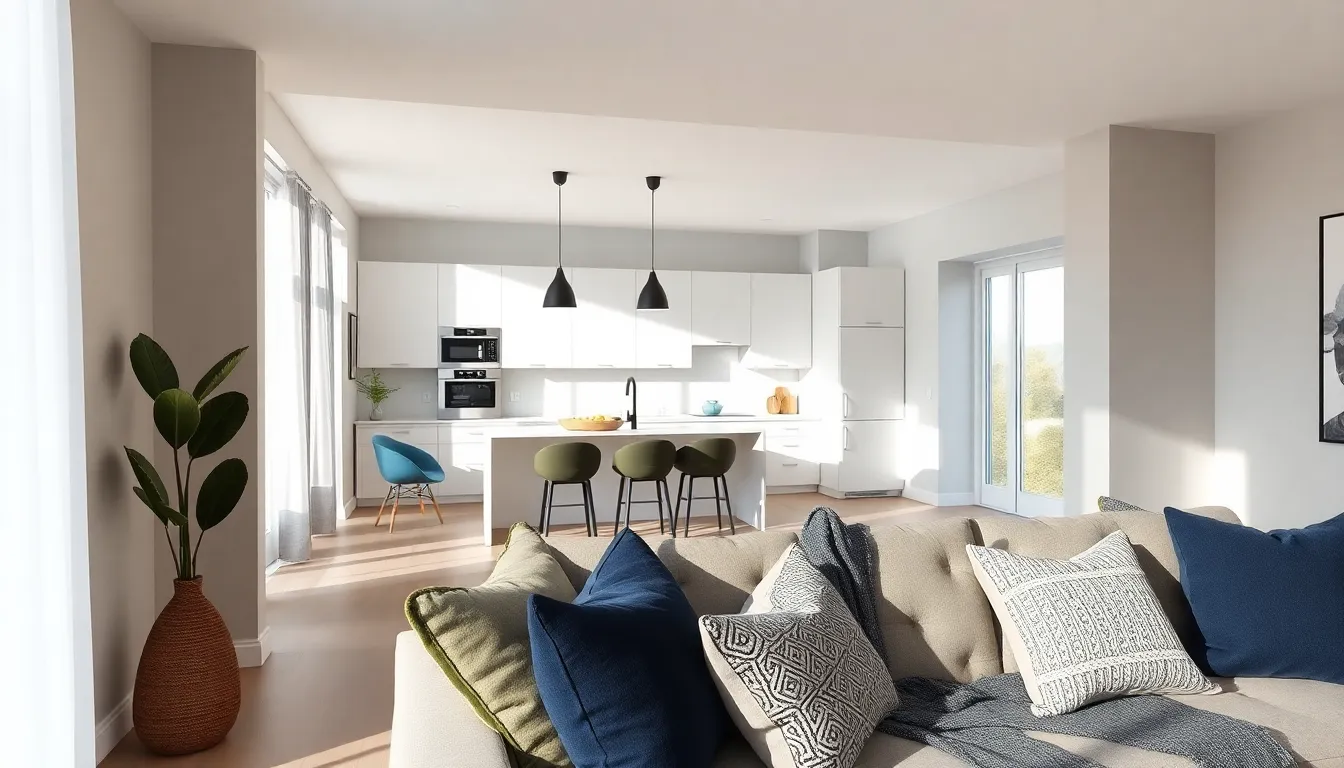
Creating visual harmony between your kitchen and living room starts with thoughtful color selection. This approach ensures both zones feel connected while maintaining their distinct functions.
Select Neutral Base Colors for Seamless Flow
Neutral base colors serve as the foundation for your open concept design. We recommend starting with whites, soft grays, or beiges as your primary palette since these shades create smooth transitions between spaces and make rooms feel larger and more connected.
These foundational colors work particularly well because they:
- Provide visual continuity across both zones
- Make spaces appear more spacious and brighter
- Offer flexibility for future decor changes
- Create a calm, uncluttered aesthetic
Whites work especially well in kitchens where cleanliness and brightness are priorities, while extending into living areas to maintain cohesion. Soft grays offer sophistication and pair beautifully with both warm and cool accent tones. Beiges bring warmth to the entire space and complement natural materials like wood and stone.
Add Accent Colors That Complement Both Areas
Accent colors introduce personality and depth to your open layout without disrupting the flow. We suggest choosing complementary shades like navy blues, earthy greens, or warm terracottas that work beautifully in both kitchen and living spaces.
Apply these accent colors strategically through:
- Kitchen accessories like dish towels, small appliances, or bar stools
- Living room textiles such as throw pillows, blankets, or curtains
- Statement furniture pieces that serve both zones
- Artwork or decorative objects visible from both areas
Navy blues create a sophisticated contrast against white or gray kitchens while adding elegance to living spaces through upholstery or artwork. Earthy greens bring natural elements indoors and work well with both modern kitchen finishes and comfortable living room furniture. Warm terracottas add energy and complement wooden elements common in both spaces.
Coordinate Paint Colors Between Kitchen and Living Room
Paint coordination doesn’t require identical colors in both spaces but rather colors within the same family or tonal range. We recommend using layered neutrals with subtle variations to maintain visual interest while preserving unity.
Effective color coordination strategies include:
- Using warm cream kitchen walls that transition to lighter beige living room walls
- Maintaining the same undertones (warm or cool) throughout both spaces
- Creating subtle contrast through different shades of the same color family
- Keeping brightness levels consistent to ensure smooth visual flow
This coordinated approach preserves an uncluttered aesthetic while allowing texture and pattern to provide visual interest. The result enhances the perception of space, functionality, and style throughout your open plan home.
Install Multi-Functional Kitchen Islands That Serve Both Areas
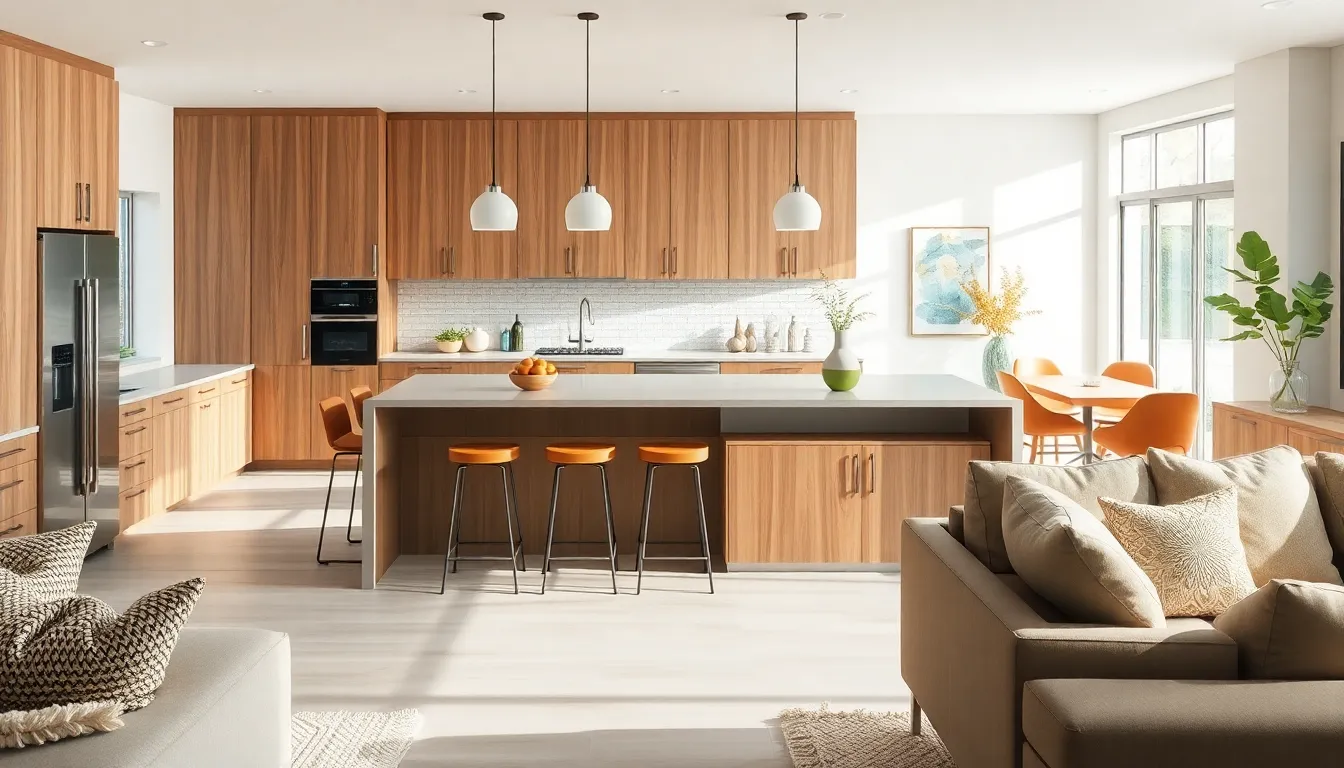
Multi-functional kitchen islands act as the central hub that seamlessly connects your kitchen and living spaces. We’ve found these versatile features provide extra counter space for meal prep, additional storage, and a natural gathering spot for family and guests.
Design Islands With Seating for Casual Dining
Bar stools transform your kitchen island into an informal dining area that encourages social interaction. We recommend incorporating integrated benches or counter-height seating that accommodates 3-4 people comfortably. Swivel stools work particularly well because they allow guests to easily turn between the kitchen activities and living room conversations.
Position seating on the living room side of your island to create a natural transition between spaces. This setup lets family members eat breakfast while others prepare meals, making morning routines more efficient. Counter-height dining also works perfectly for quick lunches or evening wine sessions while dinner cooks.
Choose seating materials that complement both your kitchen cabinetry and living room furniture. Upholstered stools in neutral tones bridge the gap between functional kitchen elements and comfortable living room aesthetics.
Include Storage Answers That Benefit Both Spaces
Built-in storage maximizes organization while keeping your open concept space clutter-free. We suggest installing deep drawers on the kitchen side for pots, pans, and cooking utensils, while adding open shelving on the living room side for books, decorative items, or entertainment accessories.
Cabinets with glass fronts work beautifully for displaying items that serve both areas, such as elegant dinnerware or decorative bowls. Hidden storage compartments can house everything from kitchen appliances to living room remotes and gaming controllers.
Repeat materials like wood or metal throughout your island storage to unify the design with both spaces. White or light-colored cabinetry helps maintain the open, airy feeling while dark wood adds warmth and sophistication to both areas.
Add Prep Space That Doubles as Serving Area
Extended counter space transforms your island into a flexible workspace that adapts to different activities throughout the day. We design islands with generous prep areas that easily transition into buffet stations during parties or family gatherings.
Install electrical outlets along the island to support both kitchen appliances and living room electronics. This functionality lets you use small appliances for food prep, then later plug in laptops or charge devices while relaxing in the living area.
Consider adding a raised bar section that separates active prep work from the seating area while maintaining visual connection. This elevation creates natural boundaries without blocking sightlines between your kitchen and living room spaces.
Maximize Natural Light With Smart Window Treatments

Natural light transforms open kitchen living rooms into bright, welcoming spaces that feel larger and more inviting. We’ll explore strategic window treatment answers that balance privacy needs with light optimization.
Choose Light-Filtering Options That Maintain Privacy
Light-filtering roller shades offer the perfect balance between privacy and brightness in our open kitchen living room designs. These versatile window treatments allow sunlight to flood the space while obscuring views from outside, creating a comfortable environment for cooking and entertaining. We recommend selecting neutral tones that complement both kitchen and living room color schemes.
Sheer curtains provide another excellent option for maximizing natural light while maintaining discretion. They soften harsh sunlight and create a gentle, diffused glow throughout the connected spaces. Layering sheer panels with heavier drapes gives us flexibility to adjust privacy levels throughout the day.
Layered window coverings deliver maximum versatility for our open concept spaces. We can combine light filtering blinds with decorative valances or pair cellular shades with flowing curtains. This approach allows us to control light levels precisely while adding visual interest to our windows.
Install Consistent Window Coverings Throughout
Consistent window treatments create visual unity between our kitchen and living areas. Installing the same style of blinds or curtains throughout the open space eliminates visual interruptions and reinforces the connected design concept. We recommend choosing one material and color that works well in both functional areas.
Matching window covering styles help establish a cohesive look across the entire open floor plan. Whether we select sleek motorized blinds or classic Roman shades, maintaining consistency in hardware finishes and operating mechanisms creates a polished appearance. This unified approach makes our spaces feel intentionally designed rather than accidentally connected.
Coordinated colors and textures strengthen the visual flow between kitchen and living zones. We suggest selecting window treatments in neutral tones that complement our established color palette. Subtle pattern variations are acceptable as long as the overall style remains consistent throughout the space.
Position Mirrors to Reflect Light Between Spaces
Mirrors positioned opposite windows amplify natural light and make our open kitchen living room appear significantly larger. This proven technique reflects sunlight throughout the connected spaces, creating brightness that travels between cooking and relaxation areas. We recommend placing large mirrors on walls that face our primary light sources.
Reflected light travels seamlessly between kitchen and living zones when we position mirrors strategically. The bounced illumination enhances the sense of openness while reducing our dependence on artificial lighting during daylight hours. Decorative mirrors serve dual purposes as functional light enhancers and stylish wall art.
Multiple mirrors create light pathways that connect different areas of our open floor plan. We can install mirrors of varying sizes to bounce light around corners and into darker spaces. This technique works particularly well when combined with our light filtering window treatments to maximize the natural illumination throughout the day.
Create Unified Flooring Solutions for Visual Continuity
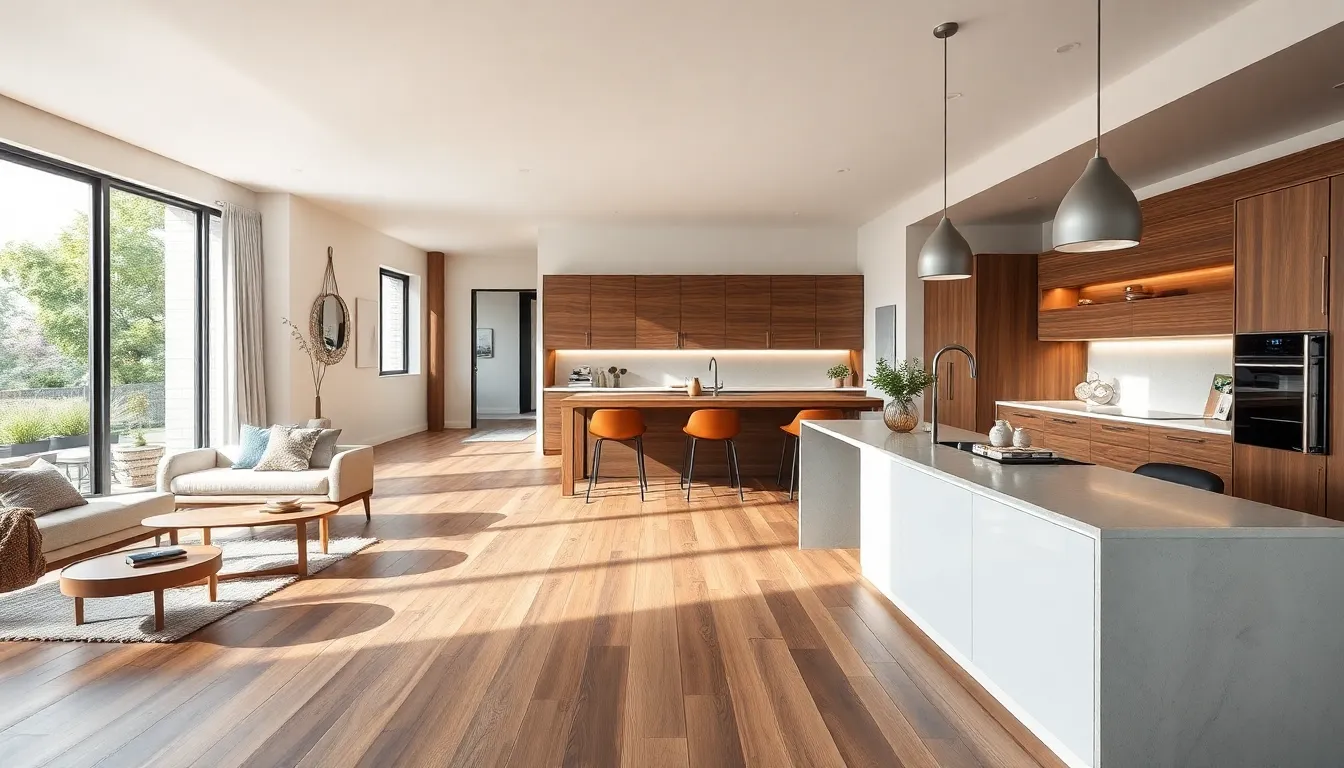
Building on our earlier design strategies, flooring serves as the foundation that truly unifies open kitchen living room spaces. We recommend using the same flooring material throughout both areas to establish visual continuity and prevent disjointed looks that can break the flow of your open concept design.
Select Durable Materials That Work in Both Areas
Engineered wood flooring stands out as our top recommendation for open kitchen living rooms because it handles moisture exposure while maintaining the warmth of natural wood. This material withstands heavy traffic from cooking activities and daily living room use without showing excessive wear patterns.
Luxury vinyl planks (LVP) offer exceptional versatility for homeowners seeking budget-friendly options that don’t compromise on style. These planks resist spills, scratches, and temperature changes while providing realistic wood or stone appearances that complement both cooking and relaxation zones.
Large format porcelain tiles deliver unmatched durability for high-traffic open spaces, especially in homes with pets or children. We’ve found that ceramic and porcelain options come in countless styles, from wood-look planks to natural stone patterns, ensuring you’ll find materials that enhance both functional and aesthetic requirements.
Use Transition Strips for Different Flooring Types
Matching transition strips create polished connections when using tile in the kitchen and wood in the living room, preventing tripping hazards while maintaining visual unity. We suggest selecting strips in tones that complement your dominant flooring material rather than creating stark contrasts.
Complementary metal finishes work exceptionally well for modern open kitchen living rooms, with brushed nickel or bronze strips adding subtle elegance to flooring transitions. These strips integrate different materials physically and visually, preserving the open concept’s sense of continuity throughout your space.
Strategic placement techniques ensure transition strips enhance rather than interrupt your design flow by positioning them at natural breaking points between functional zones. We recommend aligning strips with existing architectural elements like doorways or furniture placement to create intentional boundaries.
Consider Large Format Tiles for Seamless Appearance
24×24 inch tiles or larger minimize grout lines that can create visual interruptions in open kitchen living room designs, improving the illusion of a single, uninterrupted space. These dimensions reduce maintenance requirements while maximizing the clean, expansive appearance that modern homeowners desire.
Reduced grout lines contribute significantly to the seamless aesthetic by eliminating busy patterns that can make spaces feel fragmented or smaller. We’ve observed that fewer grout lines also mean easier cleaning and maintenance, particularly important in kitchen areas prone to spills and splashes.
Expansive visual impact results from large format installations that make both kitchen and living areas appear more spacious and cohesive. This approach works especially well in smaller open concept homes where maximizing perceived square footage is essential for comfortable daily living.
Design Smart Storage Solutions That Reduce Clutter
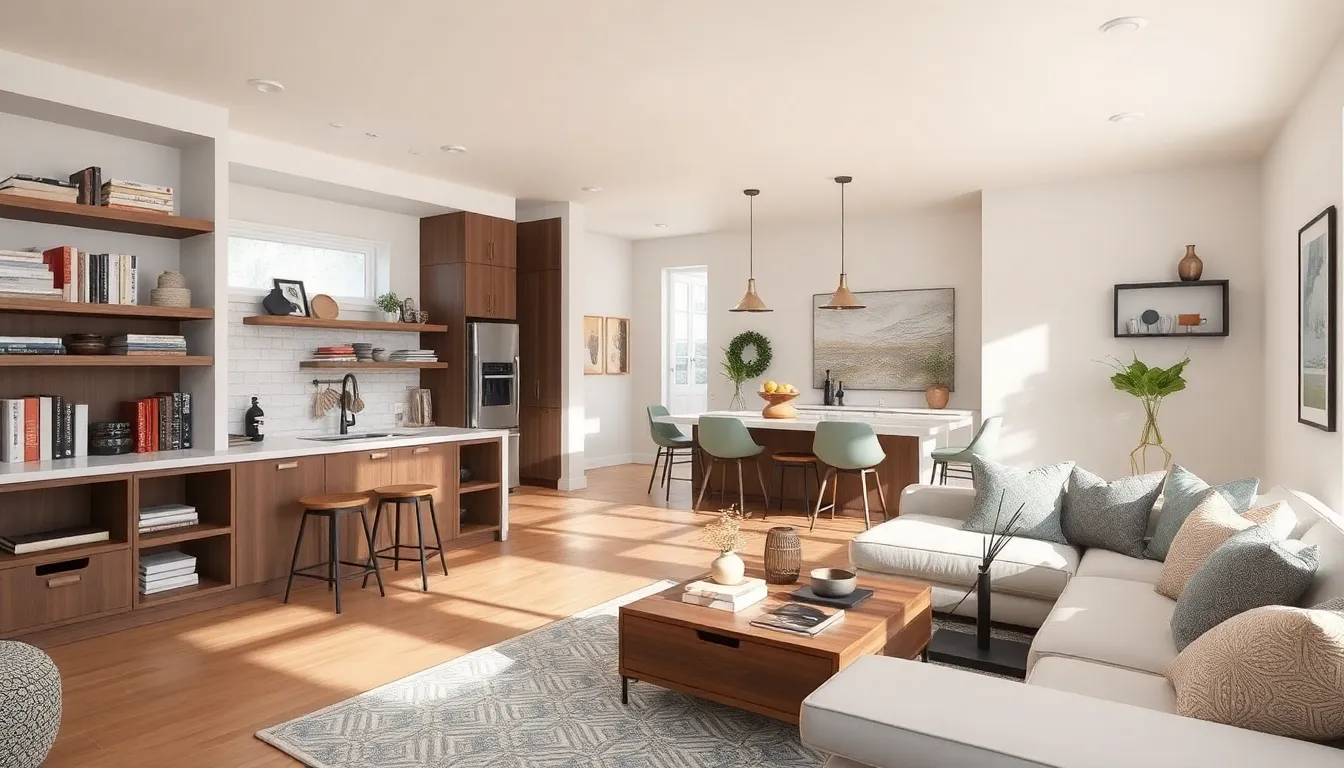
Smart storage transforms cluttered open concept spaces into organized havens where every item has its perfect place. We’ll explore three proven strategies that maximize functionality while maintaining the clean aesthetic that makes open kitchen living rooms so appealing.
Install Built-In Shelving That Serves Both Spaces
Built-in shelving creates seamless storage that works for both kitchen and living room needs without disrupting your open floor plan. We recommend installing floor to ceiling units along shared walls to maximize vertical space while providing organized storage for cookbooks, dishes, entertainment items, and decorative pieces.
Position shelving units strategically between the kitchen and living areas to create natural room dividers that maintain visual flow. Open shelving on the kitchen side can display frequently used dishes and glassware, while the living room side showcases books, plants, and personal collections.
Consider installing shelving with mixed open and closed compartments to balance display space with hidden storage. Closed cabinets on lower sections hide kitchen appliances and living room clutter, while open shelves above create an airy feel that doesn’t block sightlines across the space.
Use matching materials like natural wood or painted finishes that coordinate with your existing cabinetry to ensure the built-ins look intentional rather than added as an afterthought. Install LED strip lighting under shelves to illuminate both functional and decorative items while adding ambient lighting to the entire space.
Choose Furniture With Hidden Storage Compartments
Furniture with hidden storage compartments eliminates clutter while maintaining the clean lines essential to successful open concept design. We suggest selecting pieces that serve dual purposes, such as storage ottomans that provide seating for the kitchen island while hiding linens, games, or seasonal items inside.
Storage coffee tables offer spacious compartments for living room essentials like remote controls, magazines, and throws while keeping surfaces clear. Look for designs with lift top mechanisms or slide out drawers that make accessing stored items effortless during daily use.
Dining benches with built in storage work perfectly along kitchen islands or dining areas, providing comfortable seating while storing everything from table linens to children’s art supplies. Choose upholstered options that complement your color scheme while offering the functionality your busy household demands.
Consider media consoles with concealed storage that can house both kitchen overflow items and living room electronics. These versatile pieces work particularly well in open layouts where traditional boundaries between spaces don’t exist.
Create Designated Spots for Everyday Items
Designated spots prevent everyday clutter from accumulating on counters and surfaces throughout your open kitchen living room. We recommend establishing exact zones for daily essentials like keys, mail, charging stations, and frequently used kitchen tools to maintain the organized appearance that makes these spaces so inviting.
Install a command center near the kitchen entry with hooks for keys, a mail organizer, and a small shelf for phones and sunglasses. This dedicated zone keeps daily necessities accessible while preventing them from spreading across your beautiful countertops.
Create charging stations using decorative baskets or drawer organizers that keep electronics and cords contained but easily accessible. Position these stations strategically between the kitchen and living areas so family members can charge devices while moving freely through the space.
Establish exact homes for frequently used items like coffee supplies, cooking utensils, and living room remotes using drawer dividers and cabinet organizers. Label storage areas if necessary to help all household members maintain the organizational systems that keep your open concept space looking its best.
Use decorative trays and bowls on counters and side tables to corral small items that tend to create visual clutter. These contained collections look intentional while preventing the scattered appearance that can make open spaces feel chaotic.
Incorporate Stylish Lighting That Enhances Both Functions
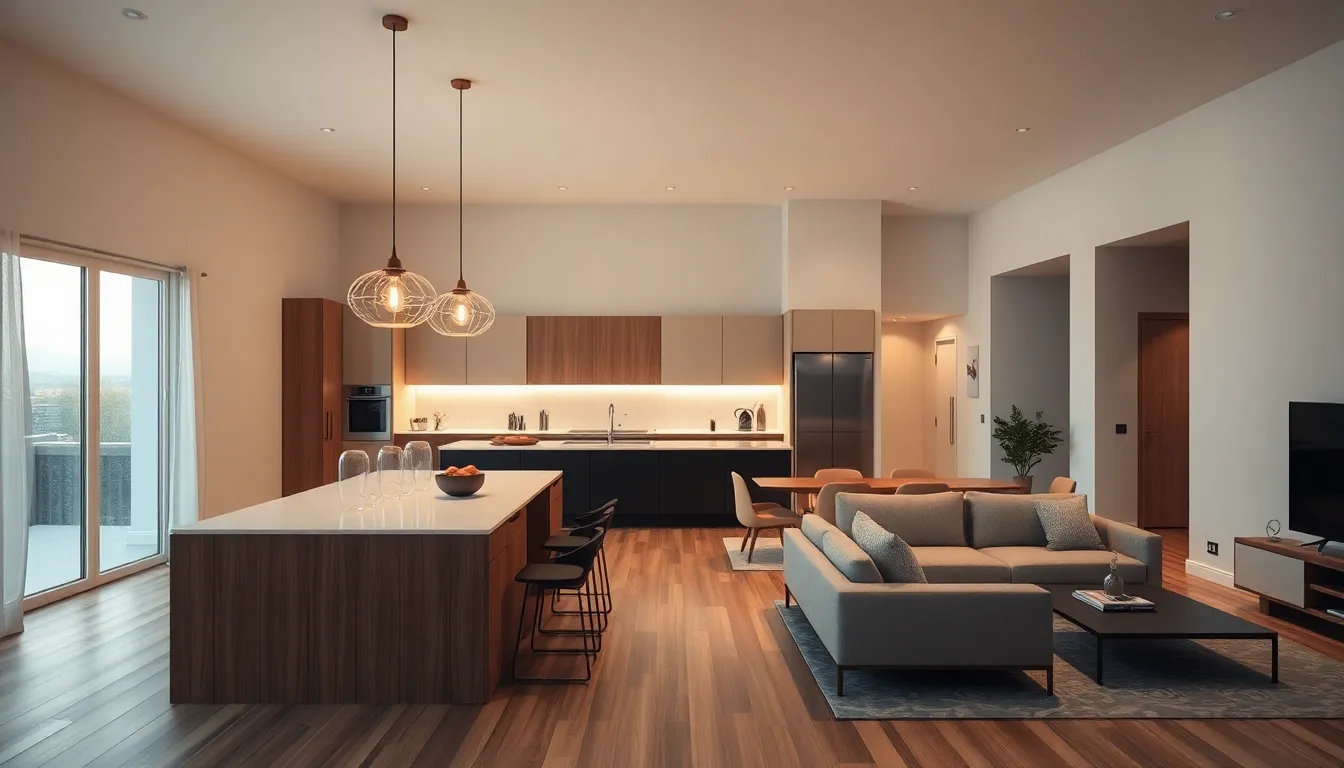
Effective lighting unifies your open kitchen living room while supporting both cooking tasks and relaxation activities. We’ll show you how to create a cohesive lighting scheme that defines each zone while maintaining visual harmony.
Layer Different Types of Lighting Throughout
Layering multiple light sources creates depth and flexibility throughout your open concept space. We recommend combining ambient, task, and accent lighting to establish distinct zones while maintaining overall cohesion.
Ambient lighting provides the foundation for your entire space through overhead fixtures like recessed lights or ceiling fans with integrated lighting. These fixtures deliver general illumination that connects both kitchen and living areas seamlessly.
Task lighting focuses on exact activities in each zone, supporting meal preparation in the kitchen and reading or working in the living room. Under cabinet LED strips illuminate countertops for cooking, while table lamps provide focused light for relaxation activities.
Accent lighting highlights architectural features and adds visual interest to your open floor plan. Wall sconces can emphasize artwork or built in shelving, while decorative fixtures create focal points that draw the eye through the connected spaces.
Smart dimmer switches give you control over each lighting layer, allowing you to adjust brightness based on the time of day and activities. This flexibility ensures your space transitions smoothly from bright cooking sessions to cozy evening entertainment.
Install Pendant Lights Over Kitchen Islands
Pendant lights serve as both practical task lighting and striking visual anchors above kitchen islands. We suggest installing these fixtures 30 to 36 inches above your island surface to provide optimal illumination for food preparation while maintaining clear sightlines across the open space.
Choose pendant styles that complement your overall design aesthetic while connecting kitchen and living room elements. Industrial metal fixtures work well in modern spaces, while glass or fabric shades soften the look for transitional designs.
Group multiple pendants over larger islands to ensure even light distribution and create visual balance. Three pendants work effectively over most standard sized islands, while two larger fixtures suit compact spaces better.
Consider adjustable height options that let you customize the lighting based on different activities. Some pendant systems include adjustable cords or tracks that accommodate various tasks from food prep to casual dining.
The focused illumination from pendant lights defines your kitchen island as a central gathering spot while contributing to the overall lighting scheme of your open concept space.
Add Ambient Lighting for Living Room Comfort
Ambient lighting in your living area creates a relaxing atmosphere that balances the brighter task lighting of your kitchen zone. We recommend incorporating multiple soft light sources to establish a cozy environment for unwinding and entertainment.
Floor lamps positioned strategically around seating areas provide gentle illumination that complements overhead fixtures. Choose styles that echo materials or finishes found in your kitchen hardware to maintain design continuity.
Table lamps on side tables or console pieces add intimate lighting layers that create warm pools of light throughout your living space. These fixtures offer the flexibility to adjust lighting levels based on different activities and moods.
Wall sconces mounted on living room walls free up surface space while providing ambient light that doesn’t compete with kitchen illumination. Consider installing these fixtures on dimmer switches for maximum control over your lighting environment.
Soft, warm light temperatures around 2700K to 3000K work best for living areas, creating a comfortable contrast to the brighter, cooler task lighting typically used in kitchen zones. This temperature difference helps visually separate the spaces while maintaining overall harmony in your open floor plan.
Select Appliances That Blend With Your Living Space Aesthetic
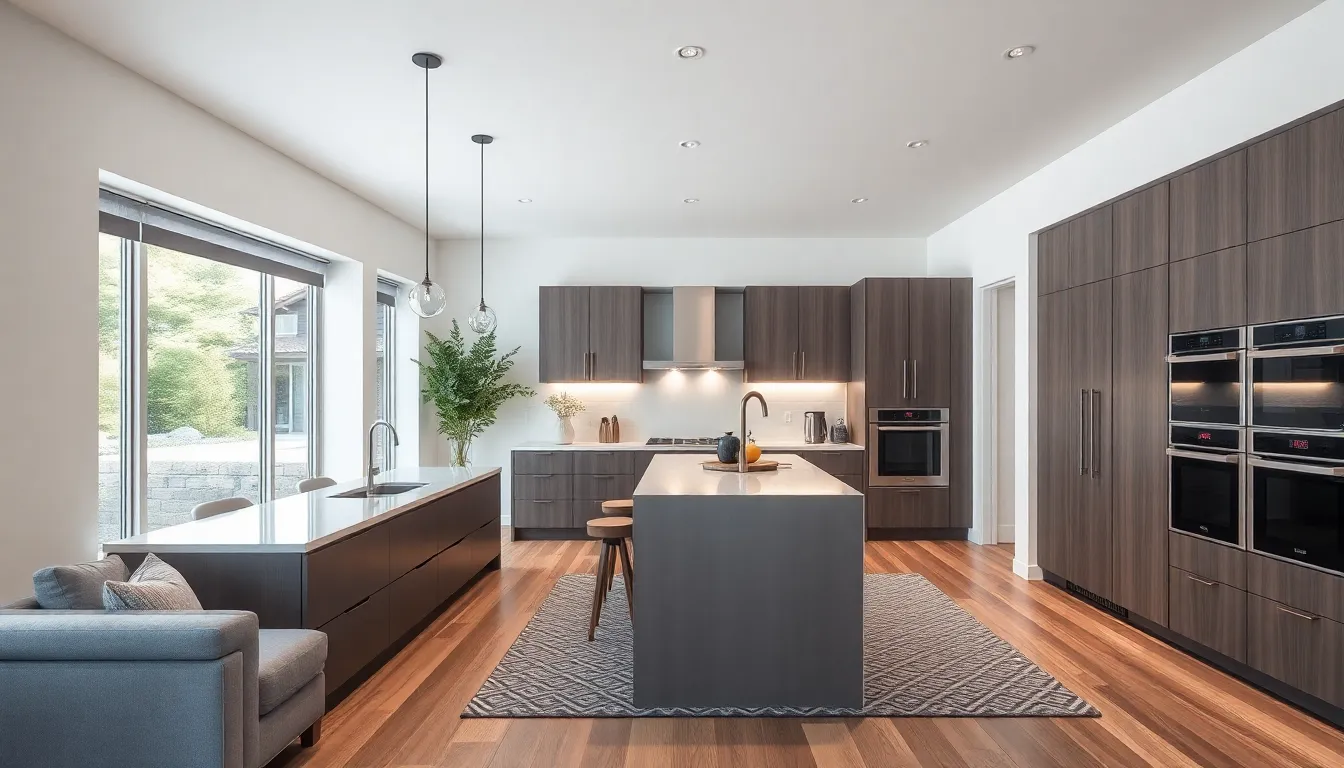
We’ve found that appliances serve as visual anchors in open kitchen living rooms, making their aesthetic integration crucial for maintaining the seamless flow between spaces. The key lies in selecting pieces that complement rather than compete with your overall design vision.
Choose Sleek Designs That Don’t Dominate the View
Sleek appliances with clean lines prevent visual clutter from overwhelming your open concept space. We recommend focusing on minimalistic features and streamlined silhouettes that fade into the background rather than demanding attention. Under-counter models like dishwashers and microwaves can be hidden behind cabinet fronts or integrated within islands and counters for a truly seamless appearance.
Built-in options work exceptionally well because they create continuity with your cabinetry while maintaining full functionality. Modern refrigerators with flat door panels and minimal hardware blend effortlessly with contemporary kitchen designs. Cooktops with sleek glass surfaces and range hoods with simple geometric shapes enhance the sophisticated aesthetic without creating visual interruptions.
Consider Panel-Ready Options for Seamless Integration
Panel-ready appliances offer the ultimate solution for achieving a cohesive look between your kitchen and living areas. These models allow custom cabinetry panels to be attached directly to appliance fronts, making refrigerators and dishwashers appear as natural extensions of your kitchen cabinetry. Fisher & Paykel, Bosch, and Sub-Zero lead the market with panel-ready options that maintain performance while disappearing into your design.
We’ve observed that panel-ready refrigerators create the most dramatic transformation in open concept spaces. The refrigerator becomes virtually invisible when matched with surrounding cabinetry, eliminating the largest visual interruption in most kitchens. Dishwashers benefit equally from this treatment, contributing to the unified aesthetic flow that makes open kitchen living rooms feel intentionally designed rather than accidentally connected.
Position Appliances to Minimize Visual Impact
Strategic appliance placement keeps large equipment from dominating sightlines between your kitchen and living areas. We position ovens, refrigerators, and range hoods away from the direct line of sight from seating areas to maintain the open feel while preserving functionality. Islands and pantry walls serve as natural screens that conceal appliances without blocking accessibility.
Corner placement works particularly well for refrigerators in open floor plans because it removes them from central viewing angles. Range hoods benefit from positioning over islands rather than against walls, creating visual separation while maintaining the connection between spaces. Thoughtful placement ensures that your appliances enhance rather than interrupt the natural flow between cooking and entertaining zones.
Add Decorative Elements That Unite Both Areas
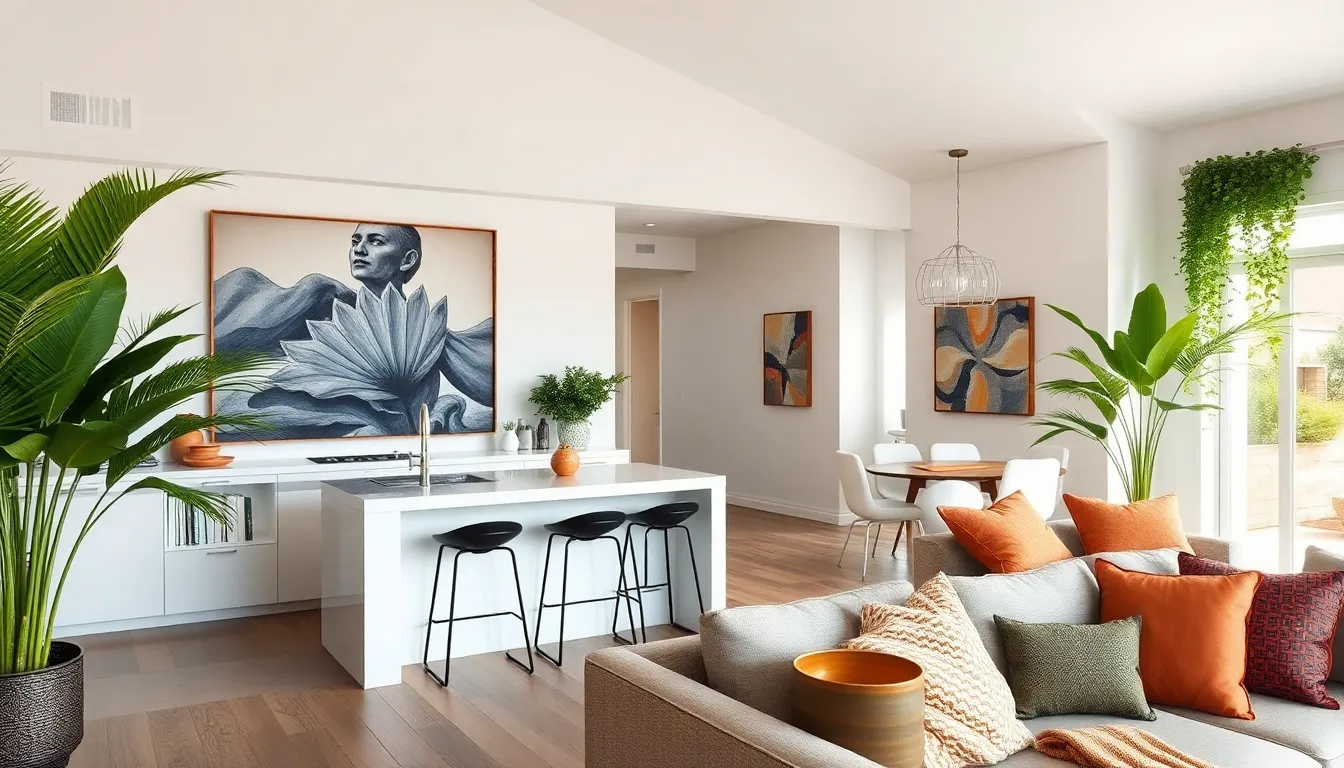
Building on your smart storage answers and lighting choices, decorative elements serve as the final layer that truly unifies your open kitchen living room. These thoughtfully chosen accents create visual bridges between the two spaces while reflecting your personal style.
Display Artwork That Complements the Entire Space
Large scale pieces work best in open concept layouts because they anchor the entire space without getting lost in the expansive area. We recommend selecting artwork that shares a consistent color scheme or theme throughout both zones, creating visual connections that guide the eye naturally from kitchen to living room.
Strategic placement enhances flow between areas when you position coordinated art collections at key sight lines. For example, hanging a series of botanical prints above your kitchen island and complementary pieces on the living room wall creates a cohesive gallery effect that ties the spaces together.
Oversized statement pieces placed in highly visible areas serve as focal points that draw attention across the entire open floor plan. Consider a large abstract painting positioned where both kitchen and living room occupants can appreciate it, or a dramatic sculpture that becomes a conversation starter during gatherings.
Include Plants That Thrive in Open Layouts
Tall specimens like palms and ficus trees excel in open spaces because they provide natural height variation without blocking sight lines between areas. These plants create soft boundaries that define zones while maintaining the airy feel that makes open concepts so appealing.
Cascading vines and trailing plants add vertical interest when placed on tall plant stands or hanging from ceiling hooks positioned strategically between kitchen and living areas. Pothos, philodendrons, and string of pearls bring natural texture that softens the transition between functional zones.
Grouped plantings create impact while establishing subtle room divisions without physical barriers. We suggest clustering plants of varying heights near the boundary between kitchen and living room, using decorative planters that complement your overall design scheme.
Low maintenance varieties ensure your green accents thrive in the high traffic environment of an open floor plan. Snake plants, ZZ plants, and rubber trees tolerate varying light conditions and require minimal care while delivering maximum visual impact.
Choose Accessories That Reflect Your Personal Style
Coordinated accessories reinforce unity throughout your open space when you select items that echo your established color palette and materials. Matching throw pillows, ceramic vases, and decorative bowls create rhythm while allowing your personality to shine through unique design choices.
Functional decorative pieces serve double duty in open layouts where every item should contribute to both aesthetics and practicality. Beautiful cutting boards displayed on your kitchen counter, stylish storage baskets, and attractive serving trays blend seamlessly between cooking and entertaining functions.
Personal collections gain prominence when displayed thoughtfully across both areas using consistent styling approaches. Whether you collect vintage pottery, modern sculptures, or family photographs, distributing pieces throughout the space creates personal touchpoints that make the area uniquely yours.
Seasonal updates keep spaces fresh without requiring major overhauls, allowing you to experiment with new trends while maintaining your core design foundation. Swapping out accent pillows, updating table centerpieces, and rotating decorative objects keeps your open kitchen living room feeling current and personalized.
Conclusion
Creating the perfect open kitchen living room doesn’t happen overnight but with these strategic design choices you’ll transform your space into a harmonious blend of functionality and style. We’ve covered everything from zoning techniques and color coordination to lighting answers and storage innovations that make these connected spaces work beautifully together.
Remember that the key lies in treating both areas as one cohesive unit while respecting their individual purposes. Whether you’re cooking for family or entertaining guests your open concept space should feel intentional and welcoming.
Start with one or two elements that resonate most with your lifestyle and build from there. Your home should reflect how you live and with these ideas you’re well-equipped to create a space that truly works for you.
Frequently Asked Questions
What is an open kitchen living room design?
An open kitchen living room design is a layout that combines cooking and entertainment spaces into one seamless area by removing walls or barriers. This creates a flowing, connected environment where family members can interact while cooking, dining, and relaxing. It goes beyond just removing walls to focus on creating a cohesive space for daily activities and gatherings.
How do I define different zones in an open floor plan?
Use strategic furniture placement to create natural boundaries between cooking and living areas. Position sofas to separate spaces, utilize area rugs to create visual divisions, and incorporate console tables as functional dividers. These elements help define zones while maintaining the open feel and flow of the space.
What color scheme works best for open kitchen living rooms?
Start with neutral base colors like whites, soft grays, or beiges to create smooth transitions and a spacious feel. Add personality with accent colors such as navy blues, earthy greens, or warm terracottas. Coordinate paint colors between both spaces using layered neutrals with subtle variations to maintain unity while adding visual interest.
What flooring should I use in an open kitchen living room?
Use the same flooring material throughout both areas to create visual continuity. Engineered wood flooring is ideal for its durability and warmth. Luxury vinyl planks and large format porcelain tiles are excellent alternatives for high-traffic areas. Use matching transition strips between different materials and choose large format tiles to minimize grout lines.
How can a kitchen island enhance an open concept space?
A multi-functional kitchen island serves as a central hub connecting both spaces. It provides extra counter space, storage, and a gathering spot for family and guests. Design islands with seating using bar stools or integrated benches to encourage social interaction. Include built-in storage and electrical outlets for maximum functionality and convenience.
What lighting works best in open kitchen living rooms?
Layer different types of lighting including ambient, task, and accent lighting to create depth and define each zone. Use pendant lights over kitchen islands for task lighting and visual anchors. Install ambient lighting in the living area for relaxation. Smart dimmer switches allow you to control brightness for different activities and times of day.
How do I maximize natural light in these spaces?
Use light-filtering roller shades and sheer curtains to balance privacy with brightness. Choose neutral tones that complement your color scheme and layer window coverings for versatility. Maintain consistent window treatment styles throughout the space. Strategically place mirrors to reflect light and enhance the sense of openness and brightness.
What storage solutions work best for open concept spaces?
Install built-in shelving that serves both kitchen and living room needs while creating natural room dividers. Choose furniture with hidden storage compartments like storage ottomans and coffee tables. Establish designated spots for everyday items such as keys and charging stations to prevent clutter from accumulating on surfaces.
How do I choose the right appliances for an open kitchen?
Select sleek, minimalistic appliances that blend with your overall aesthetic. Consider under-counter models and built-in options that maintain continuity with cabinetry. Panel-ready appliances create a cohesive look. Position larger appliances strategically to minimize visual impact and maintain an open feel while enhancing flow between cooking and entertaining zones.
What decorative elements help unify both areas?
Display large-scale artwork that complements your color scheme and strategically place plants to define zones while maintaining an airy feel. Use coordinated accessories that reflect your personal style to reinforce unity throughout the space. Consider seasonal updates to keep the design fresh and personalized while maintaining the overall cohesive aesthetic.









